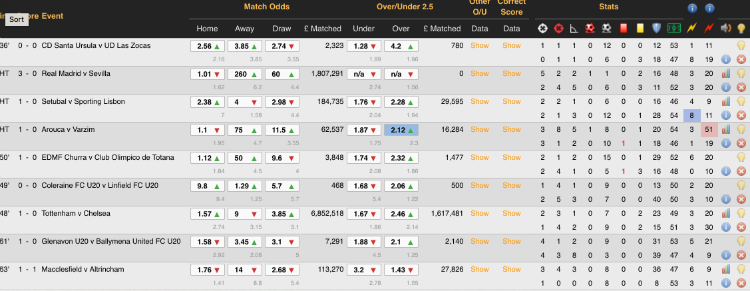1.3 Odds Daily
Posted : admin On 3/24/2022Here are all 3 odds predictions by experts for today, tomorrow and weekend. Our 3 Odds predictions cover all betting markets which include 1X2, Over/Under, Home and Away, Handicap and many more, Our 4 predictions can be played using popular betting systems which include flat betting, Martingale, Fibonacci and many more. All predictions contain the Guru name, success rate, League name, match details and expected outcome.
Staking #10,000 daily on our 5 odds means you're spending a total of #70,000 a week on the 5 odds games. With a guaranteed 5 wins a week means at the end of the week #250,000 would be left on the account. Your Profit for a week on the 5 odds stake would be (#250,000 - #70,000) #180,000. Win Daily By Single Bet(1.3 - 2 Odds) by punter9(m): 4:47pm On Dec 29, 2017 I will be posting free games here weekly. Please bet what you can afford to lose because there is no sure game. Calculating total payout: Odds x Stake = total payout e.g. 9.0 x $10 = $90 To calculate profit: (Odds x Stake) – Stake = profit e.g. (9.0 x $10) – $10 =$80; Comparing different types of odds. Whichever format odds are written in, they all have an equivalent in another format.
Page 1 of 6
3 odds Predictions
| ramor | 1 |
| Betbigga | 1 |
| Clip | 1 |
| El King | 1 |
| Kizito | 1 |
| Constant | 1 |
| Rooney | 1 |
| Greydon | 1 |
| Trust | 1 |
| 3_Odds | 2 |
| bet9ja | 1 |
| (Ultimate) | 1 |
| Preck | 1 |
| Expert picks | 1 |
| Payment | 1 |
| Jas | 1 |
| Adeyincar | 1 |
| Omo Akin | 1 |
| General | 1 |
| Aop | 1 |
| Bonus | 1 |
| Way | 1 |
| Mrp | 1 |
| Rebel | 1 |
| Successful | 1 |
| Parknbet | 1 |
| Optimumz | 1 |
| Praise | 1 |
| Van damme | 1 |
| Villa | 1 |
| Jostof | 1 |
| Diamondvid2 | 1 |
| Liverpool | 1 |
| eddie_e87 | 2 |
| Kerren | 1 |
| Lion | 1 |
| Diamondvid | 1 |
| Prediction wizard | 1 |
| Sommyroy | 1 |
| sam | 1 |
| Williams | 1 |
| Cashout | 1 |
| mania | 1 |
| #SF | 1 |
| Geo | 1 |
| Frost | 1 |
| Focus | 1 |
| EmmanuelN | 1 |
| Diamondswizzy | 1 |
| Snow girl | 1 |
Written by Clay Smith
Idiot’s Guide
That’s right - I will be your guide. The good thing about having an idiot for a guide is that I have to make it simple to understand it myself, which means, hopefully, you will understand it as well.
Probability or Odds
1.3 Odds Daily Tips
Probability
Probability means the risk of an event happening divided by the total number of people at risk of having that event. I will use the example in a recent JAMA article. In a deck of 52 cards, there are 13 spades. So, the risk (or probability) of drawing a card randomly from the deck and getting spades is 13/52 = 0.25 = 25%. The numerator is the number of spades, and the denominator is the total number of cards.
Odds
Odds seems less intuitive. It is the ratio of the probability a thing will happen over the probability it won’t. In the spades example, the probability of drawing a spade is 0.25. The probability of not drawing a spade is 1 - 0.25. So the odds is 0.25/0.75 or 1:3 (or 0.33 or 1/3 pronounced 1 to 3 odds).
Moving back and forth
To go from odds to probability, simply take the numerator/(denominator + numerator). In the spades example, the odds of 1/3 is converted by taking 1/1+3 = 0.25 - and now we are back to probability. To go from probability to odds, simply take the numerator/(denominator-numerator). In the spades example, given that the probability of drawing a spade is 1/4, take 1/(4-1) = 1:3 odds or odds = 0.33.
Statistical Significance
If an odds ratio (OR) is 1, it means there is no association between the exposure and outcome. So, if the 95% confidence interval for an OR includes 1, it means the results are not statistically significant. Example, exposure to colored vs white Christmas lights was associated with an increase in jocularity score, OR = 1.2 (95%CI 0.98-1.45). Sorry, this is not statistically significant. Let’s just go with white lights…
Use
Either the OR or risk ratio (RR) could be used in many study types. However, only the OR can be used in case-control studies. Because in order to calculate the RR, one must know the risk. Risk is a probability, a proportion of those exposed with an outcome compared to the total population exposed. This is impossible in a case-control study, in which those who already have the outcome are included without knowing the total population exposed.
Risk Ratio
RR is a very intuitive concept. It is the probability (or risk) of one outcome over the probability (risk) of another. Let’s use a study we covered on JF to discuss this concept. Survival was lower in pediatric patients intubated during arrest compared with those not intubated: 411/1135 (36%) vs 460/1135 (41%). So, the RR is 36.2%/40.5% = 0.89. This means survival was reduced by a factor of 0.89 for pediatric arrest patients who were intubated during arrest vs. those who were not. As an example, if survival was expected to be 40%, then intubating during arrest would reduce it to: 40% x 0.89 = 35.6%.
Let’s do one more example. Supination-flexion (SF) vs hyperpronation (HP) to reduce nursemaid’s elbow was more likely to fail. The risk of failure with SF was 96/351 (27%) vs. 32/350 (9%) with HP. The RR was 3. This has a very intuitive meaning: risk of failure with SF was three times more likely than HP.
Odds Ratio
The OR is a way to present the strength of association between risk factors/exposures and outcomes. If the OR is <1, odds are decreased for an outcome; OR >1 means the odds are increased for a given outcome. Let’s look at the examples again and consider odds.
For pediatric arrest, the risk of survival if intubated during arrest was 411/1135 (36%) vs 460/1135 (41%) if not intubated. Let’s convert to odds and calculate an OR.
Intubated: 411/1135-411 = 411/724 = 0.57 odds.
Non-intubated: 460/1135-460 = 460/675 = 0.68 odds.
So, the OR is 0.57/0.68 = 0.83.

Note, this is very close to the RR (0.89) but is a slight overestimate of the effect on the outcome. This is always the case with the OR compared to the RR - it overestimates the effect.
Take the example of supination-flexion vs hyperpronation for nursemaid’s. The risk of failure for SF was 96/351 vs. 32/350 with HP. Let’s convert this to odds.
SF: 96/351-96 = 0.376 odds
HP: 32/350-32 = 0.10 odds
The OR is 0.376/0.10 = 3.7
Note, the OR overestimates the RR, which was 3. Although one could say the risk of failure using SF is 3 times greater than HP, one could not say, based on the OR, the risk was 3.74 times greater. The OR and RR are not the same. What could be said is that the odds of failure is 3.74 times greater.
Risk Ratio vs Odds Ratio
Whereas RR can be interpreted in a straightforward way, OR can not. A RR of 3 means the risk of an outcome is increased threefold. A RR of 0.5 means the risk is cut in half. But an OR of 3 doesn’t mean the risk is threefold; rather the odds is threefold greater. Interpretation of an OR must be in terms of odds, not probability. Again, the OR will always be an overestimate compared to the RR. However, the RR and OR will be similar for rare outcomes, <10%. But the OR increasingly overestimates RR as outcomes exceed 10%. This is easier to understand with an example.
Pretend a new vape, Vapalicious, is associated with cancer.
80/100 people who use it get cancer.
20/100 who don’t use it get cancer.
The risk of getting cancer is 4 times greater in Vapalicious users. RR = 0.8/0.2 = 4
Note how distorted the OR becomes in this example. OR = (80/20)/(20/80) = 16

What if Vapalicious rarely caused cancer?
5/1000 get cancer with Vapalicious vs 2.5/1000 for non-users.
RR = 2.
OR = 2 as well (actually 2.005)
With rare outcomes, the RR and OR are very similar.
Why Does This Matter?
This matters because we often equate the OR and RR. Unwary researchers, reviewers, or news media might report a 16-fold increased risk of cancer from Vapalicious. In fact, there was a 4-fold increased risk of cancer from Vapalicous. Not that I plan to use Vapalicious (or any other vape), but a 16-fold vs 4-fold increase is a gross overestimation of the effect.
What Does the OR Mean?
So, what does an OR mean? Here it is in plain language.
An OR of 1.2 means there is a 20% increase in the odds of an outcome with a given exposure.
An OR of 2 means there is a 100% increase in the odds of an outcome with a given exposure. Or this could be stated that there is a doubling of the odds of the outcome. Note, this is not the same as saying a doubling of the risk.
An OR of 0.2 means there is an 80% decrease in the odds of an outcome with a given exposure.

1.3 Odds Daily Lines
Summary
How To Get 1.3 Odds Daily
Odds Ratio is a measure of the strength of association with an exposure and an outcome.
OR > 1 means greater odds of association with the exposure and outcome.
OR = 1 means there is no association between exposure and outcome.
OR < 1 means there is a lower odds of association between the exposure and outcome.
If the 95% confidence interval for the OR includes 1, the results are not statistically significant.
OR and RR are not the same.
OR always overestimate RR, but…
OR approximates RR when the outcome is rare but markedly overestimates it as outcome exceeds 10%.

References
The odds ratio by Bland and Altman, of Bland-Altman plot fame
Wikipedia aka source of all statistical knowledge